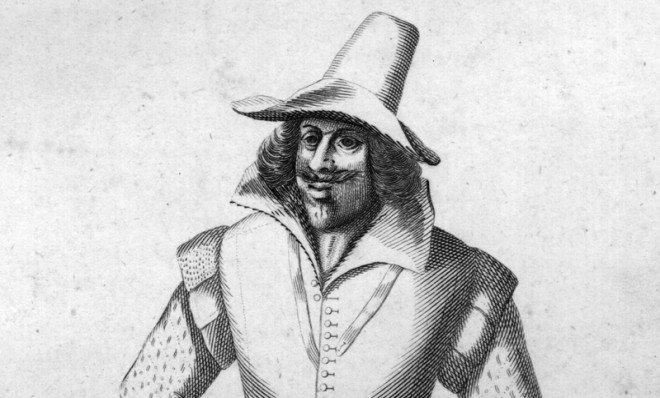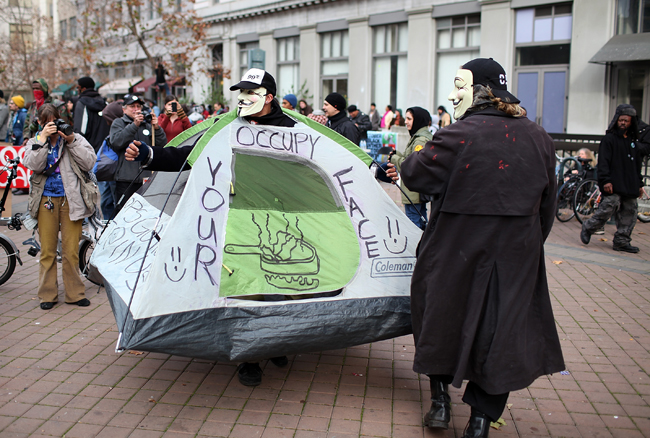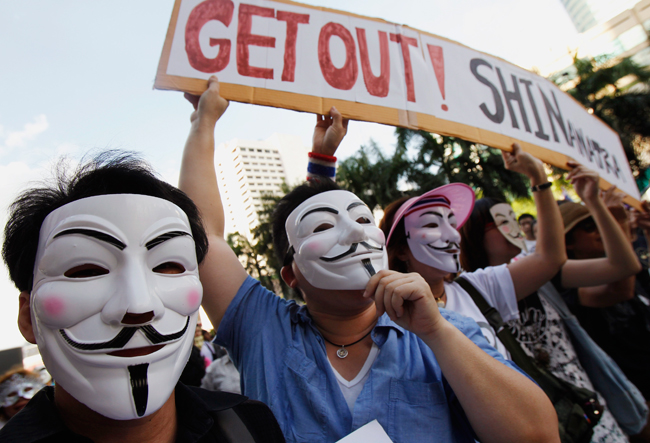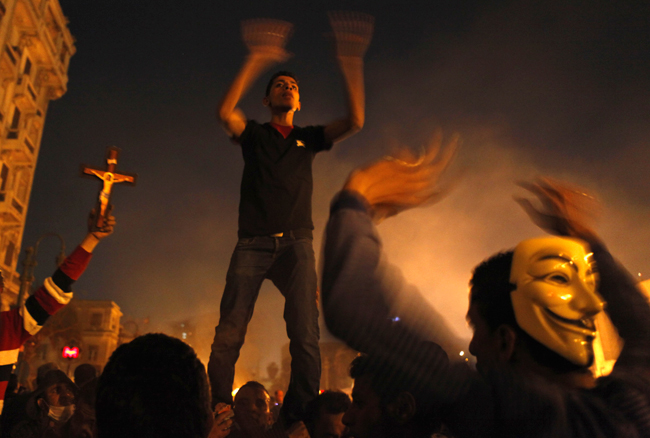A brief history of the Guy Fawkes mask
And how the mask evolved into an unlikely global symbol of rebellion

Over the past decade, dissidents across the globe have appropriated the visage of Guy Fawkes, the infamous insurgent who tried to blow up the British Parliament in 1605, warping the once-reviled fringe rebel into a widespread symbol of resistance.
The iconic version of the Guy Fawkes mask owes its popularity to the graphic novel and film V for Vendetta, which centers on a vigilante's efforts to destroy an authoritarian government in a dystopian future United Kingdom. Although he didn't predict the mask's role in popular protest, David Lloyd, the artist who illustrated the comic, told The New York Times, "It's a great symbol of protest for anyone who sees tyranny."
Before V for Vendetta (which was published in serial form throughout the 1980s before being made into a 2005 film), Guy Fawkes costumes and effigies were only popular in the U.K. on Halloween and Guy Fawkes Day, a November 5 celebration that, by the 20th century, had been largely divorced from Fawkes' violent plot.
The Week
Escape your echo chamber. Get the facts behind the news, plus analysis from multiple perspectives.

Sign up for The Week's Free Newsletters
From our morning news briefing to a weekly Good News Newsletter, get the best of The Week delivered directly to your inbox.
From our morning news briefing to a weekly Good News Newsletter, get the best of The Week delivered directly to your inbox.
But as you've likely noticed, over the past few years the stylized mask has evolved into a global symbol of dissent, employed by everyone from shadowy computer hackers to Turkish airline workers. And although the masks are often used in anti-establishment demonstrations, one of the largest media corporations in the country gains the most from the masks' rising popularity. Time Warner owns the rights to the image, and at over 100,000 masks a year, it is by far the company's best-selling facial costume.
Here, a brief history of the mask's unlikely rise:
Anonymous
The hacktivist collective Anonymous popularized these masks in 2008 when it launched Project Chanology, a movement targeting the Church of Scientology after the church tried to censor an interview with Tom Cruise on the web. Members of the collective agreed to come out from behind their computer screens to protest the Church of Scientology, but needed a way to conceal their identities. The Guy Fawkes mask was their chosen disguise. Although the collective has never officially stated the reasoning behind this choice, it's likely an homage to an eerie scene in V for Vendetta in which a group of masked protesters marches on the British Parliament. When asked why the mask was selected, one protester told The Boston Globe, "I can't say, not having contact with the inner circle — wherever they are, but I can say the image of people marching towards Parliament in the spirit of protest, that wall of masks, had a certain resonance amongst those who held negative feelings about organizations such as Scientology but also towards the government." The project grew into a national movement with demonstrations in Florida, Michigan, Boston, and Los Angeles. Since then, the masks have become a go-to symbol of the collective and anti-establishment movements worldwide.
A free daily email with the biggest news stories of the day – and the best features from TheWeek.com
After Anonymous' first major political demonstration in 2008, the collective began cleverly aligning itself with a variety of anti-establishment movements from Occupy Wall Street to the Arab Spring. It is, in part, due to these loose affiliations that the adopted emblem of one movement evolved into a global symbol of resistance.

Occupy
The Occupy Movement, born out of the Zuccotti Park-based Occupy Wall Street, adopted the mask in 2011. On Guy Fawkes Day that year, a Facebook invitation urged "all OCCUPY protesters of the world to come together on November 5th to rally again for our efforts to end corruption and social injustice." From that point on, the symbolism of the mask evolved concurrently with the movement.
It's logical that OWS would appropriate the disguise of the faceless anti-establishment crusader from Lloyd's franchise. Still, the mask doesn't carry such weight for everyone who dons it. Sid Hiltunen, an unemployed stockbroker who joined the OWS movement, told the New York Times, "If you want to show your support but are afraid you'll lose your job, just wear a mask — any mask."
Protesters around the world were spotted wearing the anti-authoritarian vigilante's trademark disguise. Even Julian Assange, the man behind WikiLeaks, wore one to an Occupy rally in London.

Protests in Thailand
This summer, another anti-government movement embraced the Guy Fawkes mask. In Thailand, protesters wore them in demonstrations against the so-called puppet administration controlled by an exiled ex-prime minister. This isn't the first time the mask has surfaced in Thailand. In 2011 a small band of protesters in Bangkok donned them the same day the "Anonymous Thailand" Facebook page launched. The masks and leaderless nature of the demonstrations are reminiscent of the global Occupy movement and the anti-establishment Anonymous message.

Turkish Airlines workers
In a contemporaneous movement, Turkish Airlines employees have adopted the masks to fight for their rights as workers.
The Middle East
The mask also played a role in the Arab Spring movements of 2011. Photos of masked protesters in Egypt also emerged this fall. The Guy Fawkes mask has become so incendiary that several Middle Eastern countries are prohibiting its import and sale. The Saudi Ministry of Interior did just that on May 30, claiming the mask "instills a culture of violence and extremism." The measure was expanded several days later to include the destruction of all masks currently in Saudi stores. In February the government in Bahrain also banned the masks.

The NSA leaker's girlfriend
The voyeuristic media coverage surrounding NSA leaker Edward Snowden's alleged girlfriend, Lindsay Mills, includes some undeniably frivolous content, but one aspect of the story is pertinent. Snowden uploaded a photo of a woman (presumably Mills) wearing a Guy Fawkes mask. As a symbol of anti-government resistance and the unofficial emblem of a pro-transparency hacktivist collective, this mask may be the most relevant piece of information surrounding her.
**
The unlikely proliferation of the Guy Fawkes mask in popular protest came as a welcome surprise to its creator. Alan Moore, author of V for Vendetta, told The Guardian, "I suppose when I was writing V for Vendetta I would in my secret heart of hearts have thought: Wouldn't it be great if these ideas actually made an impact? So when you start to see that idle fantasy intrude on the regular world… It's peculiar. It feels like a character I created 30 years ago has somehow escaped the realm of fiction."
Monica Nickelsburg is a digital producer for TheWeek.com. She has previously worked for Transient Pictures, The Daily Beast, NBC, and Forbes. Follow her @mnickelsburg.
-
 Heavenly spectacle in the wilds of Canada
Heavenly spectacle in the wilds of CanadaThe Week Recommends ‘Mind-bending’ outpost for spotting animals – and the northern lights
-
 Facial recognition: a revolution in policing
Facial recognition: a revolution in policingTalking Point All 43 police forces in England and Wales are set to be granted access, with those against calling for increasing safeguards on the technology
-
 Sudoku hard: December 14, 2025
Sudoku hard: December 14, 2025The daily hard sudoku puzzle from The Week